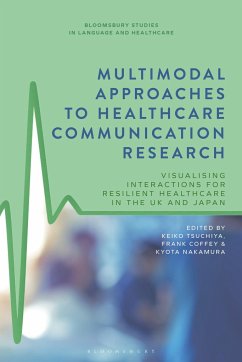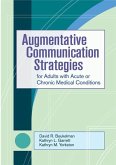Multimodal Approaches to Healthcare Communication Research
Visualising Interactions for Resilient Healthcare in the UK and Japan
Herausgeber: Tsuchiya, Keiko; Nakamura, Kyota; Coffey, Frank; Pun, Jack
Multimodal Approaches to Healthcare Communication Research
Visualising Interactions for Resilient Healthcare in the UK and Japan
Herausgeber: Tsuchiya, Keiko; Nakamura, Kyota; Coffey, Frank; Pun, Jack
- Broschiertes Buch
- Merkliste
- Auf die Merkliste
- Bewerten Bewerten
- Teilen
- Produkt teilen
- Produkterinnerung
- Produkterinnerung
Drawing on the concept of resilient healthcare, this book explores multimodally embedded everyday practices of healthcare professionals in the UK and Japan, utilising novel technology, such as eye-tracking glasses, to inform what constitutes good practice. Providing an interdisciplinary examination of the theories and rationales of resilient healthcare, the book engages with a range of case studies from a variety of healthcare settings in the UK and Japan and considers the application of advanced technologies for visualising healthcare interactions and implementing virtual healthcare…mehr
![Multimodal Studies Multimodal Studies]() Multimodal Studies74,99 €
Multimodal Studies74,99 €![Augmentative Communication Strategies for Adults with Acute or Chronic Medical Conditions Augmentative Communication Strategies for Adults with Acute or Chronic Medical Conditions]() Augmentative Communication Strategies for Adults with Acute or Chronic Medical Conditions61,99 €
Augmentative Communication Strategies for Adults with Acute or Chronic Medical Conditions61,99 €![Media and Communication Research Methods Media and Communication Research Methods]() BergerMedia and Communication Research Methods143,99 €
BergerMedia and Communication Research Methods143,99 €![Neoliberal Health Organizing Neoliberal Health Organizing]() Mohan J DuttaNeoliberal Health Organizing42,99 €
Mohan J DuttaNeoliberal Health Organizing42,99 €![The Language Hoax The Language Hoax]() John H. McWhorter (Professor of Linguisti Professor of LinguisticsThe Language Hoax14,99 €
John H. McWhorter (Professor of Linguisti Professor of LinguisticsThe Language Hoax14,99 €![On the Interactions of News Media, Interpersonal Communication, Opinion Formation, and Participation On the Interactions of News Media, Interpersonal Communication, Opinion Formation, and Participation]() Joohoan KimOn the Interactions of News Media, Interpersonal Communication, Opinion Formation, and Participation33,99 €
Joohoan KimOn the Interactions of News Media, Interpersonal Communication, Opinion Formation, and Participation33,99 €![Introduction to the World of Communication (Revised First Edition) Introduction to the World of Communication (Revised First Edition)]() Introduction to the World of Communication (Revised First Edition)207,99 €
Introduction to the World of Communication (Revised First Edition)207,99 €-
-
-
- Produktdetails
- Verlag: Bloomsbury Academic
- Seitenzahl: 230
- Erscheinungstermin: 19. September 2024
- Englisch
- Abmessung: 234mm x 156mm x 25mm
- Gewicht: 454g
- ISBN-13: 9781350298514
- ISBN-10: 1350298514
- Artikelnr.: 69121705
- Verlag: Bloomsbury Academic
- Seitenzahl: 230
- Erscheinungstermin: 19. September 2024
- Englisch
- Abmessung: 234mm x 156mm x 25mm
- Gewicht: 454g
- ISBN-13: 9781350298514
- ISBN-10: 1350298514
- Artikelnr.: 69121705
Kazue Nakajima (Osaka University Hospital
Japan) Introduction
Keiko Tsuchiya (Yokohama City University
Japan) Part I: Multimodal Practice for Resilient Healthcare Case Studies in Japan 1. Resilient Performance of a Medical Team in the Critical Care Setting
Kyota Nakamura (Osaka University Hospital
Japan) 2. Novel Approaches to Identify Preventive Factors Against Falls Among Hospital Inpatients
Takeru Abe (Yokohama City University Medical Centre
Japan) and Kyota Nakamura (Osaka University Hospital
Japan) 3. Creating Interactional Spaces for Making Requests
Kyota Nakamura (Osaka University Hospital
Japan)
Takuma Sakai (Matsuoka Emergency Medical Service
Japan)
and Keiko Tsuchiya
(Yokohama City University
Japan) Case Studies in the UK 4. A Multimodal Linguistic Analysis of Gaze and Active-Listenership in Emergency Department Team Interactions
Sarah Atkins (Aston University
UK) and Malgorzata Chalupnik (University of Nottingham
UK) 5. Projectability and Coordinated Actions in Emergency Care
Keiko Tsuchiya (Yokohama City University
Japan)
Frank Coffey (Nottingham University Hospital NHS Trust
UK)
and Alison Whitfield (Nottingham University Hospital NHS Trust
UK) Part II: Different Approaches to Healthcare Communication and Culture 6. Understanding the Impact of Restricted Interests on the Social Interactions of Adults with Autism Spectrum Disorder
Kyoko Aizaki (Lancaster University
UK)
Chris Walton (Lancaster University
UK)
and Charlie Lewis (Lancaster University
UK) 7. Beyond Lingua-cultural Barriers: Co-construction of Professional Competence by Japanese and International Care Workers
Junko Mori (University of Wisconsin-Madison
USA) and Chiharu Shima
(Akita International University
Japan) 8. Silent Replies as Indicators of Shared Common Ground between a Leader and Members in an Emergency Care Team
Akira Taneichi (Yokohama City University
Japan) 9. Different Frames in Emergency Care Interactions between the UK and Japan
Keiko Tsuchiya (Yokohama City University
Japan)
Akira Taneichi (Yokohama City University
Japan)
Frank Coffey (Nottingham University Hospital NHS Trust
UK)
and Kyota Nakamura (Osaka University Hospital
Japan) Part III: Visual and Virtual Technologies for Healthcare Simulation 10. The Creation and Validation of a 360-degree Video-Based Situation Awareness Training and Assessment Tool for Trauma Team Leaders
Andrew Mackenzie (Nottingham Trent University
UK)
Mike Vernon (Nottingham Trent University
UK)
James A. C. Myers (Nottingham Trent University
UK)
and Rob Hutton (Nottingham Trent University
UK) 11. Using Immersive Virtual Environment for Educational Purposes
Miharu Fuyuno (Kyushu University
Japan) 12. Capturing a Trauma Leader's Eye Gaze: a Semi-automatic Gaze-recognition Program
Takeshi Saitoh (Kyushu Institute of Technology
Japan)
Keiko Tsuchiya (Yokohama City University
Japan) Conclusion
Keiko Tsuchiya (Yokohama City University
Japan)
Frank Coffey (Nottingham University Hospital NHS Trust
UK)
and Kyota Nakamura (Osaka University Hospital
Japan) References Index
Kazue Nakajima (Osaka University Hospital
Japan) Introduction
Keiko Tsuchiya (Yokohama City University
Japan) Part I: Multimodal Practice for Resilient Healthcare Case Studies in Japan 1. Resilient Performance of a Medical Team in the Critical Care Setting
Kyota Nakamura (Osaka University Hospital
Japan) 2. Novel Approaches to Identify Preventive Factors Against Falls Among Hospital Inpatients
Takeru Abe (Yokohama City University Medical Centre
Japan) and Kyota Nakamura (Osaka University Hospital
Japan) 3. Creating Interactional Spaces for Making Requests
Kyota Nakamura (Osaka University Hospital
Japan)
Takuma Sakai (Matsuoka Emergency Medical Service
Japan)
and Keiko Tsuchiya
(Yokohama City University
Japan) Case Studies in the UK 4. A Multimodal Linguistic Analysis of Gaze and Active-Listenership in Emergency Department Team Interactions
Sarah Atkins (Aston University
UK) and Malgorzata Chalupnik (University of Nottingham
UK) 5. Projectability and Coordinated Actions in Emergency Care
Keiko Tsuchiya (Yokohama City University
Japan)
Frank Coffey (Nottingham University Hospital NHS Trust
UK)
and Alison Whitfield (Nottingham University Hospital NHS Trust
UK) Part II: Different Approaches to Healthcare Communication and Culture 6. Understanding the Impact of Restricted Interests on the Social Interactions of Adults with Autism Spectrum Disorder
Kyoko Aizaki (Lancaster University
UK)
Chris Walton (Lancaster University
UK)
and Charlie Lewis (Lancaster University
UK) 7. Beyond Lingua-cultural Barriers: Co-construction of Professional Competence by Japanese and International Care Workers
Junko Mori (University of Wisconsin-Madison
USA) and Chiharu Shima
(Akita International University
Japan) 8. Silent Replies as Indicators of Shared Common Ground between a Leader and Members in an Emergency Care Team
Akira Taneichi (Yokohama City University
Japan) 9. Different Frames in Emergency Care Interactions between the UK and Japan
Keiko Tsuchiya (Yokohama City University
Japan)
Akira Taneichi (Yokohama City University
Japan)
Frank Coffey (Nottingham University Hospital NHS Trust
UK)
and Kyota Nakamura (Osaka University Hospital
Japan) Part III: Visual and Virtual Technologies for Healthcare Simulation 10. The Creation and Validation of a 360-degree Video-Based Situation Awareness Training and Assessment Tool for Trauma Team Leaders
Andrew Mackenzie (Nottingham Trent University
UK)
Mike Vernon (Nottingham Trent University
UK)
James A. C. Myers (Nottingham Trent University
UK)
and Rob Hutton (Nottingham Trent University
UK) 11. Using Immersive Virtual Environment for Educational Purposes
Miharu Fuyuno (Kyushu University
Japan) 12. Capturing a Trauma Leader's Eye Gaze: a Semi-automatic Gaze-recognition Program
Takeshi Saitoh (Kyushu Institute of Technology
Japan)
Keiko Tsuchiya (Yokohama City University
Japan) Conclusion
Keiko Tsuchiya (Yokohama City University
Japan)
Frank Coffey (Nottingham University Hospital NHS Trust
UK)
and Kyota Nakamura (Osaka University Hospital
Japan) References Index








